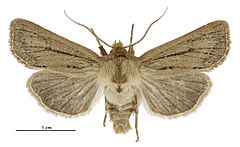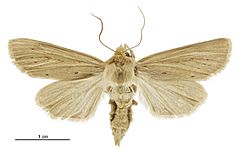Tmetolophota unica facts for kids
Quick facts for kids Tmetolophota unica |
|
|---|---|
 |
|
| Male | |
 |
|
| Female | |
| Scientific classification | |
| Kingdom: | |
| Phylum: | |
| Class: | |
| Order: | |
| Family: | |
| Genus: |
Tmetolophota
|
| Species: |
T. unica
|
| Binomial name | |
| Tmetolophota unica (Walker, 1856)
|
|
| Synonyms | |
|
|
Tmetolophota unica is a type of moth that lives only in New Zealand. It belongs to a family of moths called Noctuidae. This moth looks very much like its close cousin, Tmetolophota phaula.
Contents
Naming and Discovery
This moth was first described by a scientist named Francis Walker in 1856. He found it in a place called Waikouaiti in New Zealand. Walker gave it the name Leucania unica.
Later, in 1868, another scientist, Achille Guenée, thought he had found a new species. He named it Nonagria juncicolor. However, it turned out to be the same moth.
George Hudson, a famous New Zealand insect expert, wrote about this moth. He included it in his books in 1898 and 1928. He also realized that Guenée's name was for the same moth.
In 1971, John S. Dugdale moved this moth into a different group, or genus, called Tmetolophota. The original sample of this moth is kept at the Natural History Museum, London. More recently, in 2019, Robert J. B. Hoare suggested moving it to the genus Ichneutica.
What Does This Moth Look Like?
This moth is usually about 34 to 35 millimeters wide when its wings are spread. That's about the length of two paperclips!
Both male and female moths have a pale, yellowish-brown color. Their bodies, antennae, and legs are also this color. The male moth's antennae have small comb-like parts.
Their front wings are a bit wide and have a rounded shape. They are mostly yellowish-brown, sometimes with a few black spots. The back wings are usually grey, with some yellowish-brown near the edges.
This moth looks a lot like Tmetolophota phaula. But you can tell them apart because the male T. unica does not have jagged antennae like T. phaula.
Where Do These Moths Live?
This moth is special because it is found only in New Zealand. It lives in both the North Island and the South Island.
In the North Island, it has been seen in places like Waiouru and Ohakune. In the South Island, you might find it in Blenheim, near the Rakaia River, on Quail Island, and in cities like Dunedin. It also lives near Lake Wakatipu, Alexandra, and Macetown.
Moth Behavior and Life Cycle
You can usually see these moths flying from November to February. They are active during the warmer months.
Scientists have caught these moths using different methods. Some use "sugar trapping," which means putting out sweet bait to attract them. Others use "light trapping," where a bright light draws the moths in at night.
Studies have shown that if the weather gets warmer, these moths might grow a bit bigger.
Habitat and Food
Tmetolophota unica loves to live in open areas with lots of tussock grass. Tussock is a type of grass that grows in clumps.
The young moths, called larvae or caterpillars, eat plants. They especially like to munch on the leaves of different types of grasses, including those in the Poa genus.


